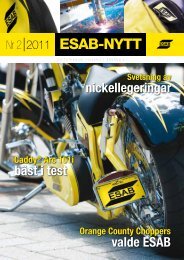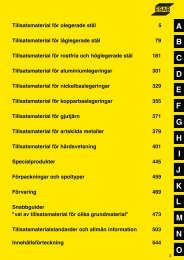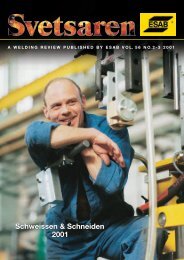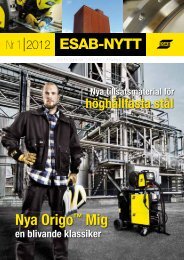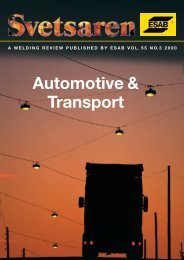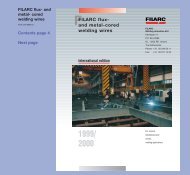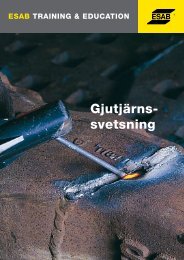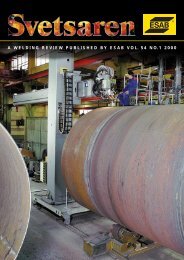Svetsaren nr 2. 2000 - Esab
Svetsaren nr 2. 2000 - Esab
Svetsaren nr 2. 2000 - Esab
- No tags were found...
Create successful ePaper yourself
Turn your PDF publications into a flip-book with our unique Google optimized e-Paper software.
4.4 Fatigue propertiesThe fatigue resistance of a weld structure is largely controlledby the geometry and quality of the weldments.The fatigue stresses on the structure in a ship comefrom two main sources, externally applied loads fromits progress through the water and initially generatedloads from the machinery. Studies of fatigue resistancehave generated a large amount of data which are summarisedas design curves in the European Recommendationsfor Aluminium Alloy Structures Fatigue Design(ECCS) [8] and British Standard 8118 “Structural Useof Aluminium” [9]. The quality of workmanship cangreatly affect the durability of structures and for manyyears the welding standards have specified quality levelsfor weldments.This investigation shows good fatigue properties forFSW samples with values above the design curves (Figures6 and 7). The absence of any weld reinforcement,which results in minimal stress concentrations, is probablya major factor contributing to the good fatigue resistance.There are some differences between the fatigueproperties of FSW welds in AA 5083 and AA6082 base material. Welds in AA 5083 have a higher fatiguerange, compared with welds in AA 6082 whichshowed a somewhat lower strength and large scatter.[5] J. Karlsson, B. Karlsson, H. Larsson, L. Karlsson, andL.-E. Svensson: Proc. INALCO 98, 7th Int. Conf. OnJoints in Aluminium, Cambridge, UK, 15-17 April1998.[6] L. Karlsson, L.-E. Svensson and H. Larsson: Proc.5th Int. Conf. on trends in welding research, PineMountains, GA, USA, 1-5 June 1998.[7] Å. Andersson, A. Norlin, and J. Backlund: Proc.International Engineering Conference “AdvancedTechnologies & Processes” Stuttgart, Germany, 30Sept-2 Oct 1997.[8] European convention for structural steelwork.European Recommendations for Aluminium AlloyStructures Fatigue Design. ECCS 68, 199<strong>2.</strong>[9] British Standard BS8118, part 1 – Structural Use ofAluminium.5.Conclusions• The microstructure and hardness in rings inside thenugget zone of friction stir welds did not differ fromthat between rings.• Most probably the nugget zone ring pattern is an effectof periodic differences in the crystallographic orientationof grains, or varying relative orientation inadjacent grains.• The hardness only varied a little across the weld inAA 5083, whereas a marked minimum was seen inthe thermomechanically-affected zone in AA 608<strong>2.</strong>• Fracture in tensile specimens coincided with the lineof lowest hardness for AA 6082 and was located inthe nugget zone for AA 5083. The fracture path wasnot related to the ring pattern.6. References[1] W.M. Thomas: Int. Patent Application No PCT/GB92/02203, 10 June 1993.[2] K.-E. Knipström, and B. Pekkari: <strong>Svetsaren</strong> Vol. 52,No 1-2, 1997, pp 49-5<strong>2.</strong>[3] P. Threadgill: TWI Bulletin, March/April, 1997, pp30-33.[4] H. Larsson, L.-E. Svensson, and L. Karlsson: Proc.Welding and Joining Science and Technology,Madrid, Spain, ASM, 10-12 March 1997.About the authorsHelena Larsson has since her graduation from Bergsskolanin Filipstad, Sweden, 1994, been working with materialsresearch at the ESAB Metallographic Laboratory inGöteborg, Sweden. Helena is mainly working with questionsconcerning welding of aluminium and its alloys.Leif Karlsson, Ph.D, Senior Expert in welding of stainlesssteels at the ESAB Central Laboratories in Göteborg,Sweden. He joined ESAB in 1986 after graduating fromChalmers University of Technology, Göteborg with aMasters degree in Engineering Physics in 1981 and finishinghis Ph.D. in Materials Science in 1986. At ESAB hehas been working with R&D on highly alloyed weld metaldevoting much time to duplex stainless weld metals. Heis currently holding a position as Manager Research Projects.Lars-Erik Svensson, Ph. D. has worked for more than 15years with welding metallurgy, focusing primarily on unalloyedand low-alloyed steels. He has published onebook and more than 25 papers on the microstructure andproperties of welds. Since August 1999 he is working atVolvo Technologycal development Corporation.10 • <strong>Svetsaren</strong> <strong>nr</strong> 2 • <strong>2000</strong>



